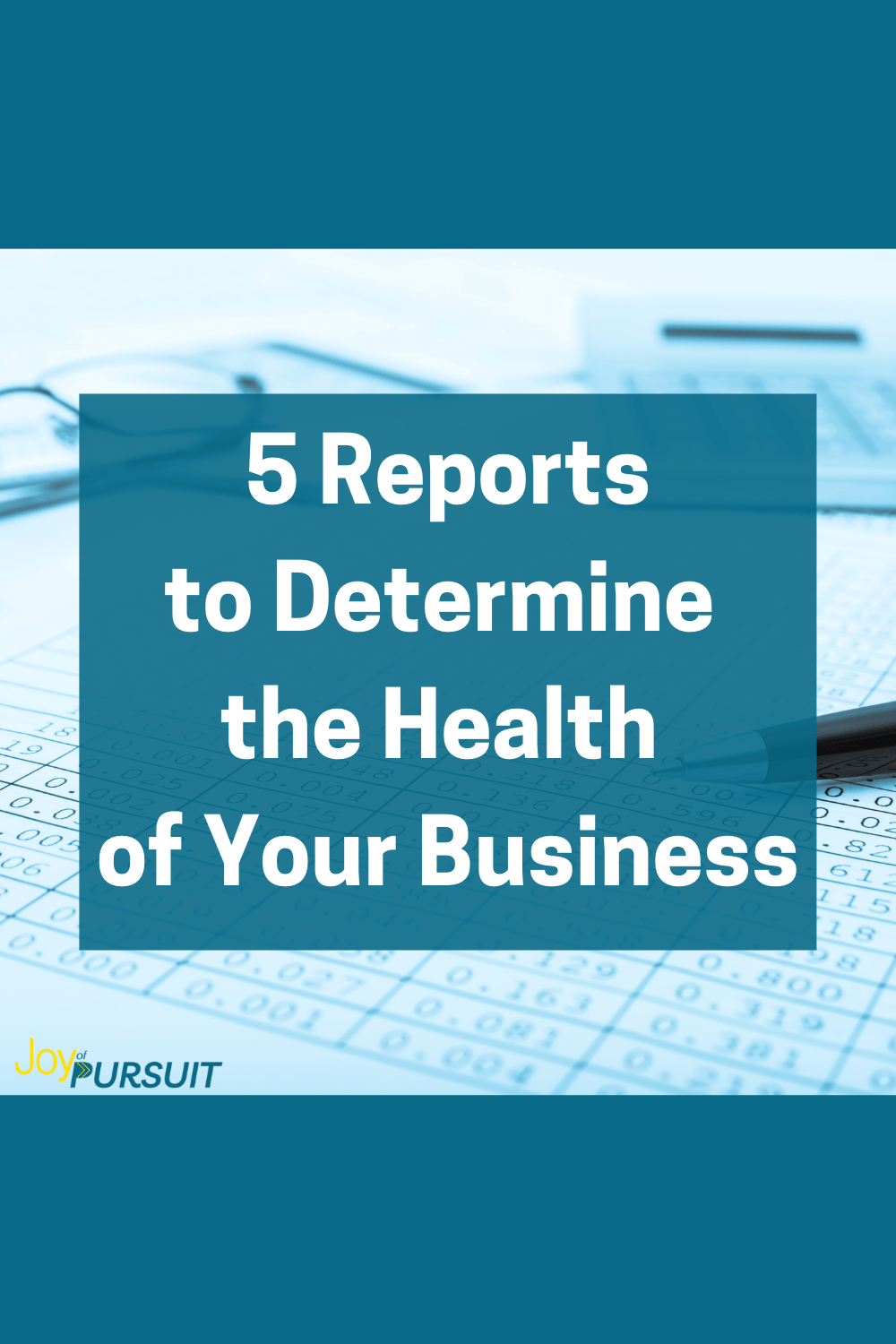These 5 Reports will Determine the Health of Your Business
Financial reports need to be evaluated in order to understand the health of your business. As a business owner, when you reflect on your time in school, was math your favorite and best subject? If your answer is no, that’s ok! As the owner, you do not have to enjoy math, spreadsheets with formulas, or account ledgers. But you do need to take the time to learn how to read some basic reports and be able to interpret their meaning for your company. Understanding the financials (and therefore company health) can assist with making decisions about marketing, pricing, employee compensation, and other business expenses.
You may think, “But the health of a business is more than just the numbers, it’s the people, customer satisfaction, harmonious work environment, and more, and those items aren’t reflected in these financial reports.” Or are they? All of the people components of your business will ultimately affect the numbers. For example, Satisfied customers will buy again, and tell their friends. Increasing revenue, without increasing marketing expenses. Unsatisfied customers won’t buy again, may require a refund, will tell their friends of their dissatisfaction, and require more customer service team hours. This will not produce revenue, harm your brand image, and will increase expenses, especially the time your customer service team spends addressing the issues.
Here are the top 5 reports you need to understand in order to determine the health of your business (including your team).
1. Profit and Loss Statement
Also known as P&L or Income Statement.
Terms:
Profit is how much income or money your company has earned.
Loss is how much money was spent.
Net Income is the difference between Profit and Loss.
At its very basic level, the P&L shows how much money your company has earned and spent for a specific timeframe. The timeframe can be this month, last quarter, year-to-date, or any other beginning and ending calendar dates. The P&L will always have a start and end date. This report can be a condensed report only showing the main categories your accounts are tracked with, or drill down into the details. Trends, both positive and negative, can be seen on the P&L when it is viewed as a comparison to previous reports. This could be last year, last quarter, or last month.
2. Balance Sheet
Terms:
Assets are what the company owns (cash, equipment, inventory).
Liabilities are what the company owes (debt, Accounts Payable).
Equity is investments and retained earnings.
A=L+E (this is the first and most important equation taught in accounting classes). Assets will always equal Liabilities plus Equity.
This report shows the financial picture of your company on a specific date. Not a range of dates like the P&L above. It is a snapshot of the financial resources of the company. Typically, this report is created at the end of an accounting period, such as monthly, quarterly, or annual. Lenders and investors will often need to see your Balance sheet before loaning or investing in your business.
3. Cash Flow Statement
This report is a blend of information from the P&L and Balance Sheet. Like the P & L, it is a report for a range of dates. As the name implies, it shows how much cash is flowing in and out of your business. This report allows you to quickly see what areas are generating and using the most cash in your company.
Cash flow for your business is categorized into three components in this statement:
Operating - related to main business activities (selling of products and services, and associated costs).
Investing - purchases of capital assets (equipment, property, vehicles, etc.).
Financing - raising money from stock or paying debt (most common for small businesses would be a small business loan).
This statement will highlight which area of the business is generating and spending the most cash. Typically, this is the general operations of a business. The numbers in this report can assist you with forecasting revenue and expenses over time, looking for seasonal trends, and are very beneficial when creating budgets.
The three reports above make up the standard financial statement package. At the bare minimum, you should be reviewing these three on a regular basis. We also suggest the next two reports be a part of your financial review to ensure you are checking on the health of your company.
4. Accounts Receivable & Accounts Payable Aging Report
Terms:
Accounts Receivable (AR): unpaid invoices your customers owe you.
Accounts Payable (AP): unpaid invoices your business owes others.
The AR Aging Report shows the duration unpaid invoices have been outstanding in 30-day increments. The details of this will assist with identifying open invoices and slow paying clients. AR can frequently be a source of cash flow problems in small businesses if it is not well managed. Having outstanding cash owed to you for long periods of time does not allow you to spend the money on the necessary operating expenses it was intended for.
If collecting on AR is an ongoing challenge for your business, we recommend reviewing this report on a weekly basis until the source of the problem is resolved. The older the debt is, the lower the likelihood of it being paid off, therefore addressing this quickly is crucial.
On the flip side, your Accounts Payable (AP) is what your business owes others, often these can be loans for new businesses, credit card debt, inventory purchases, or other suppliers. Consistently being behind on your AP is a critical problem for your business’s health and should be addressed quickly.
5. Budget vs Actual
The final report we recommend reviewing is your budget vs actual. This will show you how the company is doing compared to goals. When reviewing this report identify where you were under budget and where you were over budget. Being under budget can be an indicator that you could hire additional team members, invest more in team development, or purchase new software.
Being over budget is an indicator that too much money and resources were spent on something compared to what was originally planned. This is a signal to look closer at the issue, and solve it before it becomes a chronic problem for your cash flow.
Take the time to assess these reports on a consistent basis. Make it a top priority to do monthly, at minimum. Reviewing your finances will assist with identifying trends that can be used to make better financial decisions and address issues before they get out of control. Understanding your financial positions and health of your business will allow you to make wise business decisions and continue the pursuit of your personal and business goals.
Need help? We can assist you with creating your financial reports, evaluating the health of your business, and developing a game plan to address issues and increase your profit. Schedule a Financial Consultation today.
Welcome to Joy of Pursuit!
Pursuing your small business goals can be challenging.
Whether you are a company of one or have a team, I can assist you with building the small business of your dreams.







